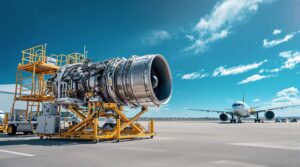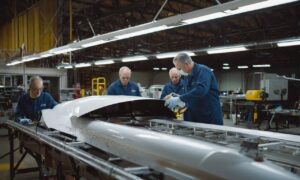In the realm of aviation, the choice between alternating current (AC) and direct current (DC) for powering large aircraft systems is a critical decision with far-reaching implications. While both AC and DC have their merits, this article will focus on the fundamental advantages of employing AC for electrical power in the context of large aircraft.
The Significance of Alternating Current (AC)
Alternating current, characterized by its cyclical change in direction, has emerged as the preferred choice for supplying electrical power to large aircraft. One of the primary advantages lies in its ability to undergo voltage transformation efficiently. AC’s inherent capability to be easily converted to different voltage levels facilitates the seamless transmission of power across various aircraft systems.
Advantage 1: Power Distribution Efficiency
One of the fundamental advantages of utilizing AC for large aircraft is the efficiency it offers in power distribution. AC power can be easily transformed to different voltage levels using transformers, allowing for more effective distribution across the aircraft. This facilitates the delivery of power to different components at the optimal voltage, reducing energy losses and enhancing overall efficiency.
Advantage 2: Weight Considerations
Weight is a critical factor in aviation, and AC systems present an advantage in terms of weight savings. AC generators can be located at strategic points in the aircraft, reducing the need for heavy, centrally located power sources. This decentralized approach not only contributes to weight reduction but also enhances the overall balance and maneuverability of the aircraft.
Advantage 3: Compatibility with In-Flight Systems
The compatibility of AC power with various in-flight systems is another key advantage. Many aircraft systems, including avionics, lighting, and entertainment systems, are designed to operate on AC power. Using AC as the primary electrical power source ensures seamless integration with these systems, eliminating the need for complex converters or additional equipment.
Advantage 4: Maintenance and Reliability
AC systems often boast enhanced reliability and ease of maintenance. The modular nature of AC components allows for easier troubleshooting and replacement, minimizing downtime during maintenance activities. Additionally, the availability of standardized AC components contributes to a streamlined maintenance process, ultimately improving the overall reliability of the aircraft’s electrical system.
Advantage 5: Future-Proofing
As technology advances, the aviation industry continually evolves. Opting for AC power systems positions aircraft for future technological developments. AC power’s adaptability and compatibility with emerging technologies make it a forward-looking choice, ensuring that the aircraft remains equipped to handle the demands of tomorrow’s innovations.
Conclusion
In conclusion, the choice of AC for electrical power in large aircraft is not arbitrary but a result of careful consideration of its numerous advantages. From efficient power distribution to weight savings and compatibility with in-flight systems, AC power emerges as a versatile and future-proof solution for the evolving needs of the aviation industry.
Fuel Efficiency and Environmental Impact
While the advantages of AC power for large aircraft primarily revolve around electrical systems, it’s crucial to highlight the broader implications related to fuel efficiency and environmental impact. AC systems, when integrated with advanced power management technologies, contribute to optimizing fuel consumption, thereby reducing the environmental footprint of aviation.
Frequently Asked Questions
For a better understanding of the role and benefits of AC power in large aircraft, here are some frequently asked questions:
| Question | Answer |
|---|---|
| 1. How does AC power contribute to weight reduction? | AC power allows for decentralized placement of generators, reducing the reliance on heavy central power sources and contributing to overall weight savings. |
| 2. Are there specific aircraft systems that benefit more from AC power? | Yes, various in-flight systems such as avionics, lighting, and entertainment systems are designed to operate optimally on AC power, ensuring compatibility and seamless integration. |
| 3. How does AC power future-proof aircraft? | AC power systems are adaptable to emerging technologies, making them a forward-looking choice that positions aircraft to meet the evolving demands of future innovations in the aviation industry. |
| 4. What role does AC power play in reducing maintenance downtime? | The modular nature of AC components simplifies troubleshooting and replacement, minimizing downtime during maintenance activities and contributing to overall system reliability. |
| 5. How does AC power contribute to power distribution efficiency? | AC power can be easily transformed to different voltage levels, allowing for more effective power distribution across the aircraft. This results in reduced energy losses and enhanced overall efficiency. |
Enhanced System Integration and Interoperability
AC power systems promote enhanced integration and interoperability among various aircraft subsystems. The standardized nature of AC components facilitates seamless communication between different systems, contributing to a more cohesive and efficient overall aircraft operation.






